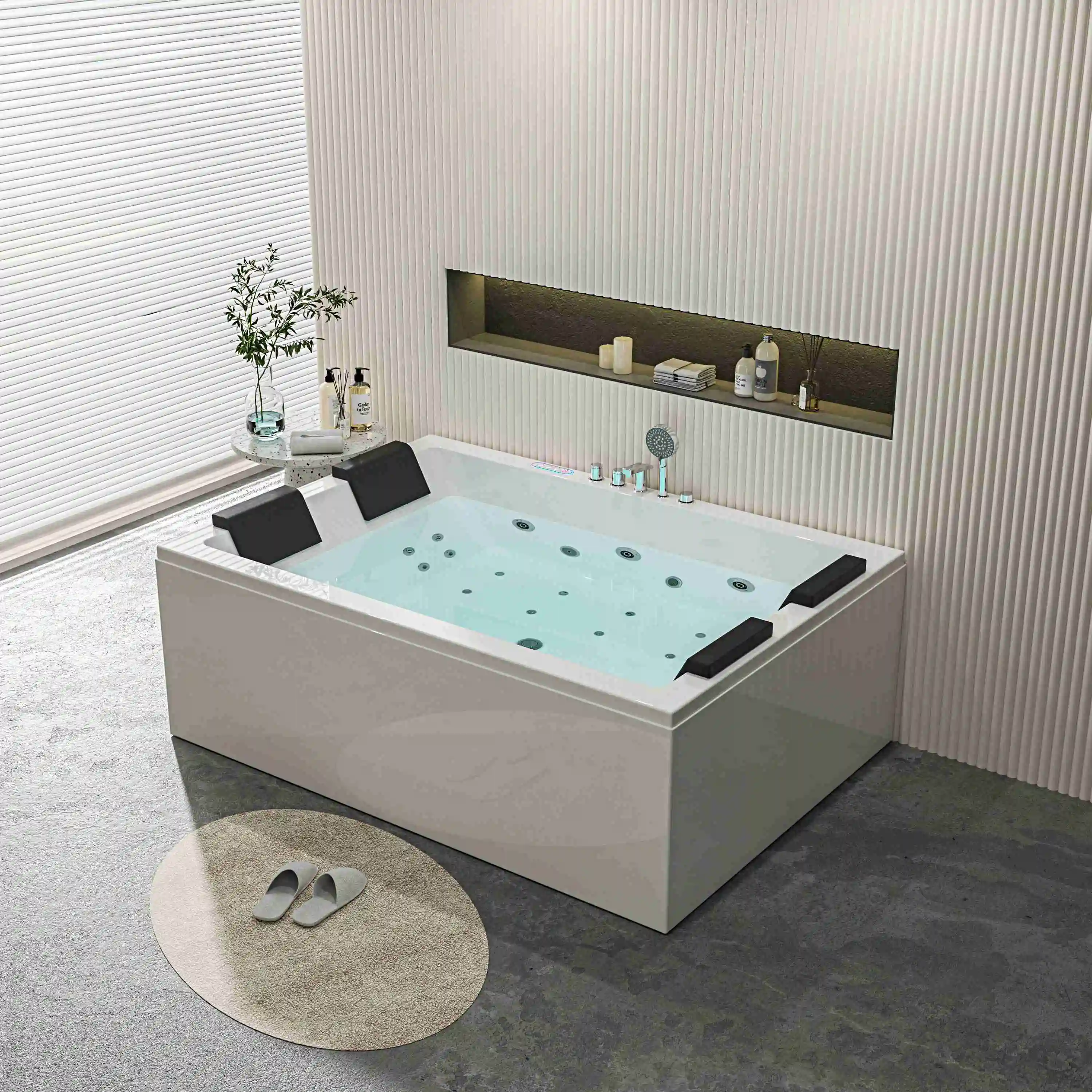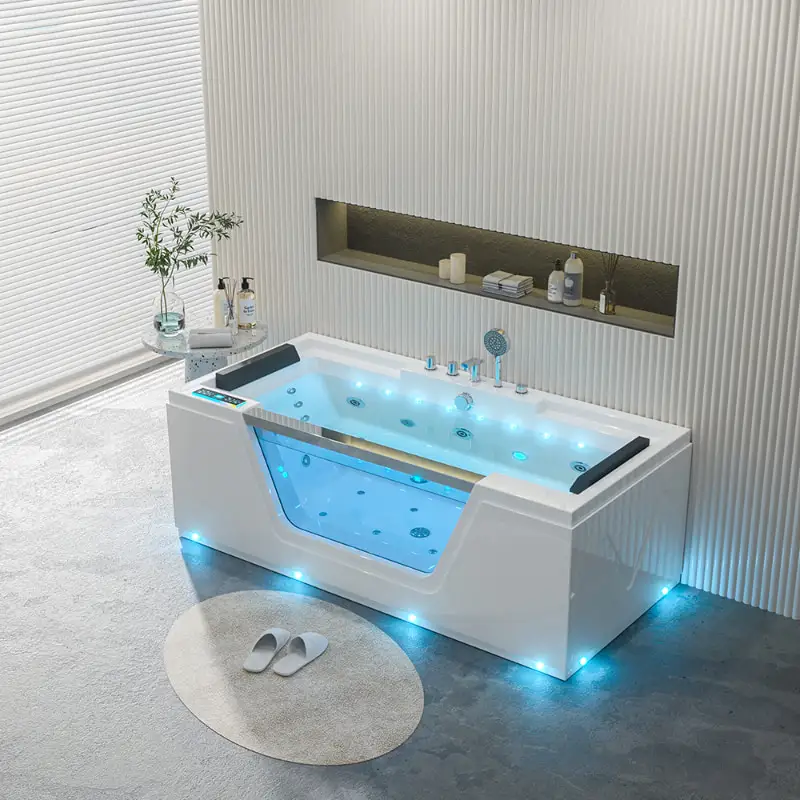Populariteti në rritje i banjave me masazh
Në vitet e fundit, banjat kanë kaluar nga hapësirat funksionale të pastër në oazë të komoditetit dhe të relaksit. Dyqana Larg , veçanërisht banjat me masazh, janë në qendër të kësaj transformimi. Ato kombinojnë lagjen tradicionale me hidroterapinë moderne, duke krijuar një përvojë që nuk është vetëm e qetësueshme por edhe e dobishme për shëndetin fizik dhe mendor. Pronarët e shtëpive dhe ofruesit e industrisë së kospitalitetit kanë njohur atraktivitetin e banjave që ofrojnë trajtime si në spa në komoditetin e hapësirave private. Duke investuar në banja me masazh, njerëzit mund të ngrinë rutinat e përditshme në rituale të mëdha të mirëqenies që mbështesin ekuilibrin dhe relaksin.
Tiparet e Banjave Moderne me Masazh
Hidroterapia dhe Sistemet e Ajrit
Masazh Dyqana Larg janë pajisur me qelqe që janë vendosur në mënyrë strategjike dhe që lëshojnë shtytje uji dhe flluska ajri. Këto qelqe i synojnë muskujt, duke u lehtësuar tensioni, ulur ngurtësinë dhe përmirësuar qarkullimin. Sipas versioneve standarde të Bathove, versionet me masazh lejojnë përdoruesit të rregullojnë nivelet e presionit, duke krijuar trajtime të personalizuara. Hidroterapia gjatë gjithë historisë është përdorur në terapi të mirëqenies, dhe integrimi i saj në Bathove e bënë relaksimin të arritshëm çdo ditë. Mundësia për të riprodhuar masazhe me cilësi spa në ambientin e shtëpia ambient është një nga përparësitë kryesore të këtyre inovacioneve.
Dizajn Ergonomik dhe i Përqendruar në Komoditet
Dizajni i gomëve për masazh shkon përtej estetikës, duke theksuar komoditetin ergonomik. Ulëset e formuara, mbështetësit e kokes me pad dhe mbështetësit e duarve të integruar sigurojnë që përdoruesit të qëndrojnë të këndshëm gjatë seancave të gjata të larjes. Sipas gomëve tradicionale, të cilat mund të ofrojnë vetëm ulje në ujë, modelet me masazh mbështesin trupin në pozicione që inkurajojnë relaksimin. Karakteristikat si sipërfaqet antizhveshtitëse dhe bassinet më të mëllëgjat bëjnë përvojën e larjes më të sigurtë dhe më të përfshirë. Këto zgjedhje të menduara të dizajnit shndërrojnë gomët në shtëpi personale ku komoditeti është prioriteti kryesor.
Benefitë Shëndetësore të Lavabove Masazh
Lëshimi i stresit dhe relaksimi mendësor
Një nga përfitimet më të rëndësishme të kadeve me masazh është aftësia e tyre për të reduktuar stresin. Kombinimi i ujit të ngrohtë dhe i vrimave të hidroterapisë shkakton lëshimin e endorfinave, që janë substancat e natyrshme të trupit për të vërshtur stresin. Kalimi i kohës në kade që janë projektuar për masazh mund të përmirësojë gjendjen e shpirtit, të lehtësojë ankthin dhe të promovojë qartësinë mendore. Për shumë përdorues, rituali i përditshëm i uljes bëhet një formë meditimi që rivendos si mendjen ashtu edhe trupin. Kjo e bënë kade të vlefshme jo vetëm për shëndetin fizik, por edhe për mirëqenien emocionale.
Lehtësimi i dhembjes dhe terapia fizike
Lagjet me masazh njihen gjithashtu për efektin e tyre terapeutik në menaxhimin e dhembjeve. Kushtet si artroz, dhembja e kurrizit të poshtëm dhe lëndimet muskulore përfitojnë nga seancat e rregullta të hidroterapisë. Jetet stimulojnë qarkullimin e gjakut, ulin inflamacionin dhe nxitin shërimin më të shpejtë. Për individët me dhembje kronike, lagjet që përfshijnë funksione masazhi ofrojnë lehtësim jo-invaziv dhe pa ilaçe. Profesionistët e kujdesit shëndetësor rekomandojnë shpesh hidroterapinë si një trajtim komplementar, duke theksuar vlerën e lagjeve me masazh në strategjitë e shëndetit holistike.
Teknologjia dhe Inovacioni në Lagje
Kontrolle të Mençura dhe Programe të Personalizuara
Teknologjia ka përmirësuar në mënyrë të konsiderueshme përdorshmërinë e bathoreve në vitet e fundit. Bathoret e masazhit tani kanë kontrolla digjitale, duke lejuar përdoruesit të rregullojnë me saktësi temperaturën e ujit, intensitetin e jetit dhe modet e masazhit. Disa modele të përparuara ofrojnë programe të paracaktura që janë projektuar për relaksim, rimëkëmbje apo sesione që ngjallin energji. Lidhja me aplikacione mobile apo sisteme shtëpie inteligjente lejon përdoruesit të kontrollojnë bathoret në distancë, duke programuar banjo që janë të gatshme në momentin e mbërritjes. Këto inovacione pasqyrojnë tendencën e gjerë të personalizimit në teknologjitë e mirëqenies.
Integrimi i tipareve të mirëqenies
Kadhot e masazhit gjithnjë e më shumë integrojnë tipare të mirëqenies që shkojnë përtej hidroterapisë. Drita me ngjyra në kromoterapi përdoret për të krijuar efekte qetësuese ose ngjallëse, ndërsa aromaterapia e futhë ajrin me erëra ulëse. Altoparlantët me Bluetooth lejojnë përdoruesit të dëgjojnë muzikë qetësuese ose meditata të udhëzuar gjatë banjos. Këto përmirësime transformojnë kadhët në qendra të mirëqenies me shumë ndjesi, që i përgjigjen individëve që kërkojnë një qasje të tërësishme ndaj relaksimit. Përzierja e teknologjisë me banjën tradicionale garanton që përvoja të jetë e mprehtë dhe terapeutike.

Konsiderata për Jetën dhe Dizajnin
Tërheqja e Luksit dhe Spës së Shtëpisë
Lagjet me masazh po bëhen elemente qendrore në banjot moderne, duke simbolizuar luksin dhe indulgjencën. Përfshirja e tyre ngrinë dizajnin e shtëpisë, duke u përputhur me tendencën e rritjes së krijuar të mjediseve të ngjashme me spa në hapësirat banuese. Për pronarët e shtëpive, shtimi i lagjeve me masazh nuk vetëm që përmirëson komoditetin por edhe rrit vlerën e pronës. Shtëpitë e pushimit dhe rezortet e përdorin në mënyrë të ngjashme këto lagje për të tërhequr mysafirët që kërkojnë përvoja të veçanta të mirëqenies. Duke bashkuar funksionalitetin me dizajnin, lagjet me masazh i përcaktojnë përsëri kuptimin e relaksimit në shtëpi.
Përdorshmëria dhe Përfshirja
Lagjet e sotme adresojnë gjithashtu nevojën për përfshirje. Lagjet me masazh të llojit 'walk-in' me dyer hyrëse të lehta dhe sipërfaqe antizhveshtëse sigurojnë që individët e moshuar apo ata me lëvizje të kufizuar të mund të shijojnë përfitimet e hidroterapisë. Kontrollues të rregullueshëm dhe dizajne të përdorura lehtë e bëjnë lagjet të qasshme për një publik të gjerë, duke u rritur rolin e tyre si mjete universale të mirëqenies. Tani qasshmëria është një prioritet në dizajn, duke siguruar që lagjet i përgjigjen përdoruesve të ndryshëm pa komprometuar luksin apo performancën.
Qëndrueshmëria në Lavabotët me Masazh
Inovacionet për kursim të ujit
Me shqetësimet e rritura për ambientin, lagjet janë ridadhësuar për të gjetur një ekuilibër midis luksit dhe qëndrueshmërisë. Lagjet me masazh tani kanë sisteme mekanike që kursisin ujë dhe zvogëlojnë konsumin pa prekur performancën. Bazinet me kapacitet më të vogël dhe sisteme të dreneimit të avancuara sigurojnë një funksionim miqësor me ambientin. Këto inovacione pasqyrojnë kërkesën e konsumatorëve për produkte përgjegjëse ndaj ambientit që vazhdojnë të ofrojnë komoditet premium.
Efikasiteti energjetik dhe materiale të gjelbra
Sistemet e ngrohjes në Bathore tradicionalisht konsumonin sasi të mëdha energjie, por modele moderne përdorin materiale të izoluara dhe ngrohëse me eficiencë energjetike për të minimizuar humbjet. Disa Bathore janë ndërtuar me kompozite miqëse me ambientin ose materiale që mund të riciklohen, duke i bërë më të qëndrueshme në përgjithësi. Duke adopsion teknologji të gjelbra, prodhuesit sigurojnë që Bathoret të përputhen me stiljet e jetës së ndërgjegjshme për ambientin. Kjo angazhim për qëndrueshmërinë e rritëtë tërheqjen e tyre në mes të konsumatorëve modernë.
E ardhmja e Bathoreve me Masazh
Integrimi me shtëpitë e mençura
Në të ardhmen, Bathoretë do të vazhdojnë të evoluojnë si pjesë e ekosistemeve të shtëpive inteligjente. Kontroll me komandë zanore, alarma për mirëmbajtje paralajmëruese dhe personalizim i drejtuar nga AI janë tashmë tendenca që po dalin. Bathoretë do të mësojnë preferencat e përdoruesve, duke u rregulluar automatikisht për të krijuar përvoja ideale larjeje. Kjo integrim i lehtë do të bëjë Bathoretë jo vetëm mjete për relaksim por dhe pajisje inteligjente për mirëqenien.
Zgjerimi i Rolit në Kujdesin Parandalues të Shëndetit
Duke u vendosur mirëqenia në qendër të jetës së përditshme, banjot me ujë të nxehtë do të pozicionohen gjithnjë e më shumë si zgjidhje për shëndetësinë preventivë. Sesionet e rregullta të hidroterapisë mund të mbështesin shëndetin kardiovaskular, të zvogëlojnë sëmundjet e lidhura me stresin dhe të përmirësojnë cilësinë e gjumit. Duke paraqitur banjot me ujë të nxehtë si investime të nevojshme për mirëqenien, prodhuesit dhe furnizuesit e zgjerojnë rolin e tyre përtej luksit, duke i bërë këto të domosdoshme për stilje jetese më të shëndetshme në mbarë botën.
FAQ
Cilat janë përfitet kryesore të banjave me masazh
Banjat me masazh ofrojnë lehtësim nga stresi, menaxhim të dhimbjeve dhe qarkullim të përmirësuar të gjakut. Po ashtu, ato ofrojnë relaksim si në spa në shtëpi, duke e përmirësuar mirëqenien fizike dhe mendore.
Si dallohen banjat me funksion masazhi nga ato të rregullta
Sipas banjave standarde, modelet me masazh përfshijnë pisha hidroterapie, ulëse ergonomike dhe kontrollues të zgjuar. Këto tipare krijojnë një përvojë të personalizuar dhe terapie të banjës.
A janë lagjet me masazh të shoqërueshme me ambientin
Po, shumë lavabo moderne përfshijnë vrima që kursen ujë, ngriçës të energjisë sëfiqe dhe materiale të qëndrueshme. Ato ekuilibrojnë luksin me përgjegjësinë mjedisore.
A mundëjnë Lavabot me funksione masazhi të ndihmojnë në probleme shëndetësore
Po, lavabot me masazh përdoren gjerësisht për kushte si artroz, dhimbje muskulore dhe dhimbje kronike. Ato ofrojnë lehtësim pa ilaç dhe mbështesin rutinat e terapisë fizike.

